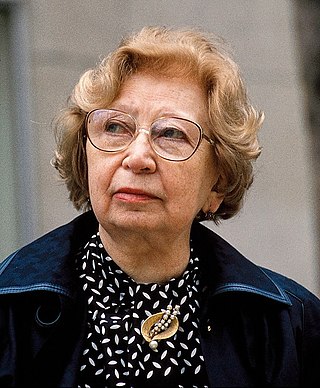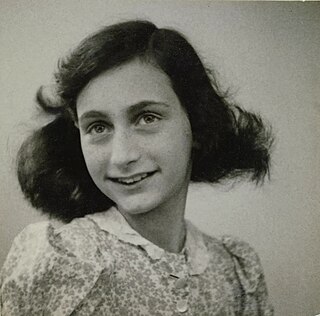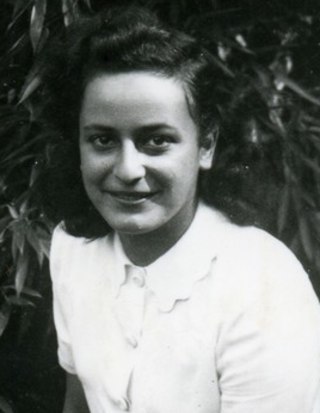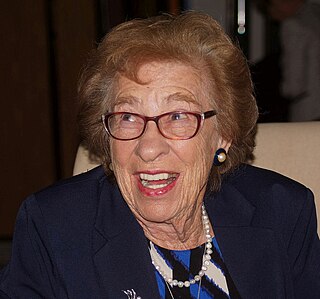The following lists some references to the Holocaust-era Jewish diarist Anne Frank in popular culture .
Contents

The following lists some references to the Holocaust-era Jewish diarist Anne Frank in popular culture .


Otto Heinrich Frank was the father of Anne Frank. He edited and published the first edition of her diary in 1947 and advised on its later theatrical and cinematic adaptations. In the 1950s and the 1960s, he established European charities in his daughter's name and founded the trust which preserved his family's wartime hiding place, the Anne Frank House, in Amsterdam.

The Diary of Anne Frank is a 1959 American biographical drama film based on the Pulitzer Prize-winning 1955 play of the same name, which was in turn based on the posthumously published diary of Anne Frank, a German-born Jewish girl who lived in hiding in Amsterdam with her family during World War II. It was directed by George Stevens, a Hollywood filmmaker previously involved with capturing evidence of concentration camps during the war, with a screenplay by Frances Goodrich and Albert Hackett. It is the first film version of both the play and the original story, and features three members of the original Broadway cast.

Hermine "Miep" Gies was one of the Dutch citizens who hid Anne Frank, her family and four other Dutch Jews from the Nazis in an annex above Otto Frank's business premises during World War II. She was Austrian by birth, but in 1920, at the age of eleven, she was taken in as a foster child by a Dutch family in Leiden to whom she became very attached. Although she was only supposed to stay for six months, this stay was extended to one year because of frail health, after which Gies chose to remain with them, living the rest of her life in the Netherlands.

Annelies Marie "Anne" Frank was a German-born Jewish girl who kept a diary in which she documented life in hiding under Nazi persecution during the German occupation of the Netherlands. She is a celebrated diarist who described everyday life from her family's hiding place in an Amsterdam attic. One of the most-discussed Jewish victims of the Holocaust, she gained fame posthumously with the 1947 publication of The Diary of a Young Girl, in which she documents her life in hiding from 1942 to 1944 — it is one of the world's best-known books and has been the basis for several plays and films.

The Diary of a Young Girl, commonly referred to as The Diary of Anne Frank, is a book of the writings from the Dutch-language diary kept by Anne Frank while she was in hiding for two years with her family during the Nazi occupation of the Netherlands. The family was apprehended in 1944, and Anne Frank died of typhus in the Bergen-Belsen concentration camp in 1945. Anne's diaries were retrieved by Miep Gies and Bep Voskuijl. Miep gave them to Anne's father, Otto Frank, the family's only survivor, just after the Second World War was over.

Karl Josef Silberbauer was an Austrian police officer, Schutzstaffel (SS) member, and undercover investigator for the West German Bundesnachrichtendienst. He was stationed in Nazi-occupied Amsterdam during World War II, where he was promoted to the rank of Hauptscharführer. In 1963, Silberbauer, by then an inspector in the Vienna police, was exposed as the commander of the 1944 Gestapo raid on the Anne Frank House Secret Annex and the arrests of Anne Frank, her fellow fugitives, and two of their protectors, Victor Kugler and Johannes Kleiman.

Friedrich "Fritz" Pfeffer was a German dentist and Jewish refugee who hid with Anne Frank and her family and the Van Pels family during the Nazi occupation of the Netherlands. He perished in the Neuengamme concentration camp in Northern Germany. Pfeffer was given the pseudonym Albert Dussel in Frank's diary, and remains known as such in many editions and adaptations of the publication.
The Holocaust has been a prominent subject of art and literature throughout the second half of the twentieth century. There is a wide range of ways–including dance, film, literature, music, and television–in which the Holocaust has been represented in the arts and popular culture.

Anne Frank and Me is a 2001 novel by husband and wife writing team Cherie Bennett and Jeff Gottesfeld. Inspired by the life of Anne Frank, it follows a teenage girl named Nicole Burns who travels back in time to 1942 and inhabits the body of a Jewish Holocaust victim. The novel was adapted from a play written and directed by Bennett in 1996.

Rut "Rutka" Laskier was a Jewish Polish diarist who is best known for her 1943 diary chronicling the three months of her life during the Holocaust in Poland. She was murdered at Auschwitz concentration camp in 1943 at the age of fourteen. Her manuscript, authenticated by Holocaust scholars and survivors, was published in the Polish language in early 2006. English and Hebrew translations were released the following year. It has been compared to the diary of Anne Frank.

Hélène Berr was a French woman of Jewish ancestry and faith, who documented her life in a diary during the time of Nazi occupation of France. In France she is considered to be a "French Anne Frank". She died from typhus during an epidemic of the disease in Bergen-Belsen concentration camp that also killed Anne Frank and her sister Margot.

Hannah Elisabeth Pick-Goslar was a German-born Israeli nurse and Holocaust survivor best known for her close friendship with writer Anne Frank. The girls attended the 6th Montessori School in Amsterdam and then the Jewish Lyceum. During The Holocaust, they saw each other again whilst imprisoned at Bergen-Belsen concentration camp. Goslar and her young sister were the only family members who survived the war, being rescued from the Lost Train. Both emigrated to Israel, where Hannah worked as a nurse for children. They shared their memories as eyewitnesses of the Holocaust.

Eva Schloss is an Austrian-English Holocaust survivor, memoirist and stepdaughter of Otto Frank, the father of Margot and diarist Anne Frank. Schloss speaks widely of her family's experiences during the Holocaust and is a participant in the USC Shoah Foundation's Visual History Archive project to record video answers to be used in educational tools.

Laureen Nussbaum is a German-born American scholar and writer. She is best known for being a Holocaust survivor, and as a scholar and childhood friend of the famed memoirist Anne Frank. Nussbaum is frequently consulted on Anne Frank works and literature.

The Anne Frank Human Rights Memorial is a .81 acres (0.33 ha) cenotaph complex and educational park in Boise, Idaho near the Boise Public Library and the Greenbelt, the centerpiece of which is a statue of Anne Frank; it is jointly maintained by the Wassmuth Center for Human Rights and the Boise Department of Parks and Recreation, and is the only human rights memorial in the U.S. Designed by Idaho Falls architect Kurt Karst, a sapling of the Anne Frank Tree and quotations from some sixty notables and unknowns are prominent installations. It also features one of the few installations where the full text of the Universal Declaration of Human Rights is on permanent public display. The park has been recognized and accepted by the International Coalition of Sites of Conscience. It was thoroughly renovated in September 2018, with an outdoor classroom and a new sculpture, "The Spiral of Injustice."
Nanette Konig-Blitz is a Bergen-Belsen concentration camp survivor and former classmate of Anne Frank. She has lived in São Paulo, Brazil since 1953. In 2015, she published a book about being a Belsen survivor called Eu Sobrevivi ao Holocausto. On Holocaust Memorial Day 26 January 2018, Nanette's book was published in English with the title Holocaust Memoirs of a Bergen-Belsen Survivor & Classmate of Anne Frank.
Renia Spiegel was a Jewish-Polish diarist who was killed during World War II in the Holocaust.

Eva Heyman was a Jewish girl from Oradea. She began keeping a diary in 1944 during the German occupation of Hungary. Published under the name The Diary of Eva Heyman, her diary has been compared to The Diary of a Young Girl by Anne Frank. She discusses the extreme deterioration of the circumstances the Jewish community faced in the city, offering a detailed account of the increasingly restrictive anti-Jewish laws, the psychological anguish and despair, the loss of their rights and liberties and the confiscation of property they endured. Heyman was 13 years old when she and her grandparents were murdered in the Holocaust.

Annelies is a 2019 novel by David R. Gillham, which has a depiction of Anne Frank surviving her term in the Bergen-Belsen concentration camp and reuniting with her father, Otto Frank.